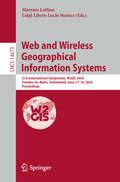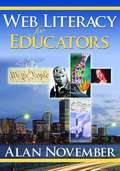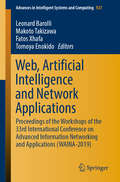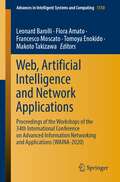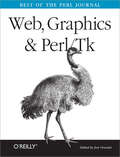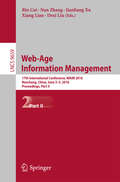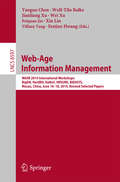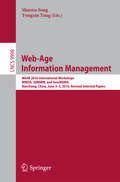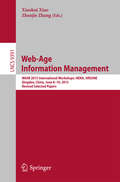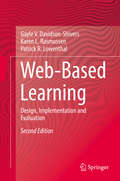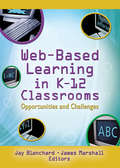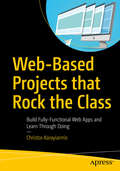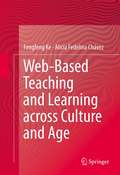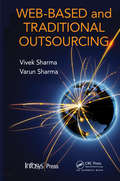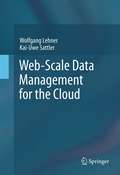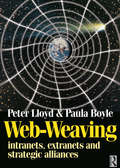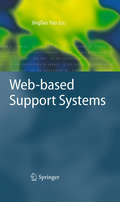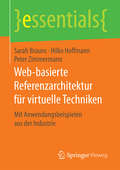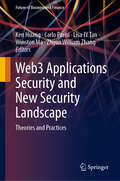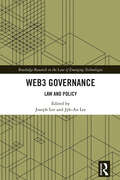- Table View
- List View
Web and Wireless Geographical Information Systems: 21st International Symposium, W2GIS 2024, Yverdon-les-Bains, Switzerland, June 17–18, 2024, Proceedings (Lecture Notes in Computer Science #14673)
by Maryam Lotfian Luigi Libero Lucio StaraceThis book constitutes the refereed proceedings of the 21st International Symposium on Web and Wireless Geographical Information Systems, W2GIS 2024, held in Yverdon-les-Bains, Switzerland, during June 18–19, 2024. The 8 full papers and 7 short papers included in this book were carefully reviewed and selected from 20 submissions. The book also contains one invited talk. They were organized in topical sections as follows: Spatiotemporal Data Analysis, Open Data and Reproducible Research, Geospatial Technologies and Tools, Advanced Computing and GIS Applications, Transportation Applications, and Doctoral Symposium.
Web for Literacy Educators
by Alan NovemberThe author offers exercises, examples, handouts, and basic tips to help both learners and educators find and evaluate information on the Web for quality and validity.
Web, Artificial Intelligence and Network Applications: Proceedings of the Workshops of the 33rd International Conference on Advanced Information Networking and Applications (WAINA-2019) (Advances in Intelligent Systems and Computing #927)
by Fatos Xhafa Makoto Takizawa Leonard Barolli Tomoya EnokidoThe aim of the book is to provide latest research findings, innovative research results, methods and development techniques from both theoretical and practical perspectives related to the emerging areas of Web Computing, Intelligent Systems and Internet Computing. As the Web has become a major source of information, techniques and methodologies that extract quality information are of paramount importance for many Web and Internet applications. Data mining and knowledge discovery play key roles in many of today’s prominent Web applications such as e-commerce and computer security. Moreover, the outcome of Web services delivers a new platform for enabling service-oriented systems. The emergence of large scale distributed computing paradigms, such as Cloud Computing and Mobile Computing Systems, has opened many opportunities for collaboration services, which are at the core of any Information System. Artificial Intelligence (AI) is an area of computer science that build intelligent systems and algorithms that work and react like humans. The AI techniques and computational intelligence are powerful tools for learning, adaptation, reasoning and planning. They have the potential to become enabling technologies for the future intelligent networks. Recent research in the field of intelligent systems, robotics, neuroscience, artificial intelligence and cognitive sciences are very important for the future development and innovation of Web and Internet applications.
Web, Artificial Intelligence and Network Applications: Proceedings of the Workshops of the 34th International Conference on Advanced Information Networking and Applications (WAINA-2020) (Advances in Intelligent Systems and Computing #1150)
by Makoto Takizawa Leonard Barolli Tomoya Enokido Flora Amato Francesco MoscatoThis proceedings book presents the latest research findings, and theoretical and practical perspectives on innovative methods and development techniques related to the emerging areas of Web computing, intelligent systems and Internet computing. The Web has become an important source of information, and techniques and methodologies that extract quality information are of paramount importance for many Web and Internet applications. Data mining and knowledge discovery play a key role in many of today’s major Web applications, such as e-commerce and computer security. Moreover, Web services provide a new platform for enabling service-oriented systems. The emergence of large-scale distributed computing paradigms, such as cloud computing and mobile computing systems, has opened many opportunities for collaboration services, which are at the core of any information system. Artificial intelligence (AI) is an area of computer science that builds intelligent systems and algorithms that work and react like humans. AI techniques and computational intelligence are powerful tools for learning, adaptation, reasoning and planning, and they have the potential to become enabling technologies for future intelligent networks. Research in the field of intelligent systems, robotics, neuroscience, artificial intelligence and cognitive sciences is vital for the future development and innovation of Web and Internet applications.
Web, Graphics & Perl/Tk Programming
by Jon OrwantIn its first five years of existence, The Perl Journal (TPJ) became the voice of the Perl community. Every serious Perl programmer subscribed to it, and every notable Perl guru jumped at the opportunity to write for it. TPJ explained critical Perl topics and demonstrated Perl's utility for fields as diverse as astronomy, biology, economics, AI, and games. Back issues were hoarded, or swapped like trading cards. No longer in print format, The Perl Journal remains a proud and timeless achievement of Perl during one of its most exciting periods of development. Web, Graphics & Perl/Tk is the second volume of The Best of the Perl Journal, compiled and re-edited by the original editor and publisher of The Perl Journal, Jon Orwant. In this series, we've taken the very best (and still relevant) articles published in TPJ over its five years of publication and immortalized them into three volumes. The forty articles included in this volume are simply some of the best Perl articles ever written on the subjects of graphics, the Web, and Perl/Tk, by some of the best Perl authors and coders. Much of Perl's success is due to its capabilities for developing web sites; the Web section covers popular topics such as CGI programs, mod_perl, spidering, HTML parsing, security, and content management. The Graphics section is a grab bag of techniques, ranging from simple graph generation to ray tracing and real-time video digitizing. The Perl/Tk section shows you how to use the popular Perl/Tk toolkit for developing graphical applications that work on both Unix/Linux and Windows without a single change. Written by twenty-three of the most prominent and prolific members of the closely-knit Perl community, including Lincoln Stein, Mark-Jason Dominus, Alligator Descartes, and Dan Brian, this anthology does what no other book can, giving unique insight into the real-life applications and powerful techniques made possible by Perl.
Web-Age Information Management
by Bin Cui Jianliang Xu Nan Zhang Xiang Lian Dexi LiuThis two-volume set, LNCS 9658 and 9659, constitutes the thoroughly refereed proceedings of the 17th International Conference on Web-Age Information Management, WAIM 2016, held in Nanchang, China, in June 2016. The 80 full research papers presented together with 8 demonstrations were carefully reviewed and selected from 266 submissions. The focus of the conference is on following topics: data mining, spatial and temporal databases, recommender systems, graph data management, information retrieval, privacy and trust, query processing and optimization, social media, big data analytics, and distributed and cloud computing.
Web-Age Information Management
by Bin Cui Jianliang Xu Nan Zhang Xiang Lian Dexi LiuThis two-volume set, LNCS 9658 and 9659, constitutes the thoroughly refereed proceedings of the 17th International Conference on Web-Age Information Management, WAIM 2016, held in Nanchang, China, in June 2016. The 80 full research papers presented together with 8 demonstrations were carefully reviewed and selected from 266 submissions. The focus of the conference is on following topics: data mining, spatial and temporal databases, recommender systems, graph data management, information retrieval, privacy and trust, query processing and optimization, social media, big data analytics, and distributed and cloud computing.
Web-Age Information Management
by Wei Xu Yueguo Chen Wolf-Tilo Balke Jianliang Xu Peiquan Jin Xin Lin Tiffany Tang Eenjun HwangThis book constitutes the refereed proceedings of 5 workshops of the 15th International Conference on Web-Age Information Management, WAIM 2014, held in Macau, China, June 16-18, 2014. The 38 revised full papers are organized in topical sections on the 5 following workshops: Second International Workshop on Emergency Management in Big Data Age, BigEM 2014; Second International Workshop on Big Data Management on Emerging Hardware, HardBD 2014; International Workshop on Data Management for Next-Generation Location-based Services, DaNoS 2014; International Workshop on Human Aspects of Making Recommendations in Social Ubiquitous Networking Environment, HRSUME 2014; International Workshop on Big Data Systems and Services, BIDASYS 2014.
Web-Age Information Management
by Shaoxu Song Yongxin TongThis book constitutes the refereed proceedings of 3 workshops of the 17th International Conference on Web-Age Information Management, WAIM 2016, held in Nanchang, China, in June 2016. The three workshops were as follows: * The International Workshop on Spatiotemporal Data Management and Mining for the Web (SDMMW 2016) * The International Workshop on Semi-structured Big Data Management and Applications (SemiBDMA 2016). * The International Workshop on Mobile Web Data Analytics (MWDA2016)
Web-Age Information Management
by Xiaokui Xiao Zhenjie ZhangThis book constitutes the refereed proceedings of 2 workshops of the 16th International Conference on Web-Age Information Management, WAIM 2015, held in Qingdao, China, June 8-10, 2015. The 9 revised full papers are organized in topical sections on the two following workshops: International Workshop on Heterogeneous Information Network Analysis and Applications (HENA 2015), and Second International Workshop on Human Aspects of Making Recommendations in and for Social Ubiquitous Networking Environments (HRSUNE 2015).
Web-Age Information Management: WAIM 2016 International Workshops, MWDA, SDMMW, and SemiBDMA, Nanchang, China, June 3-5, 2016, Revised Selected Papers (Lecture Notes in Computer Science #9998)
by Shaoxu Song and Yongxin TongThis book constitutes the refereed proceedings of 3 workshops of the 17th International Conference on Web-Age Information Management, WAIM 2016, held in Nanchang, China, in June 2016.The three workshops were as follows: • The International Workshop on Spatiotemporal Data Management and Mining for the Web (SDMMW 2016) • The International Workshop on Semi-structured Big Data Management and Applications (SemiBDMA 2016). • The International Workshop on Mobile Web Data Analytics (MWDA2016)
Web-Based Education in the Human Services: Models, Methods, and Best Practices
by Richard Schoech Brenda Moore Robert James Macfadden Marilyn HerieA much-needed look at innovative and effective methods for creating virtual learning environments for human servicesWeb-Based Education in the Human Services reflects the vitality and diversity of Web-based courses currently delivered within human services. Unlike previous texts that have combined technologies such as Interactive Television (ITV) and two-way audio where Web involvement was minimal, this unique book focuses on Web-based models, tools, and techniques used in courses where the majority of the content is delivered online. The book&’s contributors emphasize the social aspects of learning, examining topical areas not usually associated with Web-based education as they remind us of the need to move beyond the similarities between WBE and face-to-face (FTF) approaches.Web-Based Education in the Human Services documents a course delivery method coming of age in its desire to create virtual learning environments that incorporate a variety of techniques and strategies. These environments use concepts and tools beyond what packages such as WebCT currently offer, highlighting the power of designing a complete Web-based curriculum, rather than viewing each course separately. Many of the most successful approaches presented in this invaluable book don&’t involve sophisticated tools or programming, but the creative design of interactive scenarios, emotional content, and feedback mechanisms that reinforce the instructor&’s role as the crucial ingredient for success. Web-Based Education in the Human Services examines: adult learning theories teaching practice skills through Web-based technology how to bridge the gap between theory and practice faculty perceptions of the effectiveness of Web-based instruction compared to face-to-face instruction the accessibility of Web-based education the significance of emotion in learning Web-based delivery of a graduate professional training program the creation, delivery, and evaluation of a pilot course using Blackboard 6 the development of a Web-based undergraduate child welfare course the use of Web-based video clips for counselor skills training the design, development, pilot, and revision of a Web-based social work practice course an online format for agency-based field instruction the design of a Web-based graduate program in counseling psychology and much more!Web-Based Education in the Human Services is an invaluable resource for social work and human services educators, including education, nursing, and psychology, Web-course developers, and college and university administrators.
Web-Based Learning
by Gayle V. Davidson-Shivers Karen L. Rasmussen Patrick R. LowenthalThis second edition is a practical, easy-to-read resource on web-based learning. The book ably and clearly equips readers with strategies for designing effective online courses, creating communities of web-based learners, and implementing and evaluating based on an instructional design framework. Case example, case studies, and discussion questions extend readers skills, inspire discussion, and encourage readers to explore the trends and issues related to online instructional design and delivery.
Web-Based Learning in K-12 Classrooms: Opportunities and Challenges
by James Marshall Jay BlanchardMake sure your students get the most from their online learning experiencesEven though nearly every K-12 public school in the United States has broadband Internet access,the Web&’s vast potential as a teaching and learning tool has still not been realized. Web-based learning opportunities have been expensive, slow to develop, and time-consuming to implement, despite pressure on schools to adopt technology solutions that will cure their educational ills. Web-Based Learning in K-12 Classrooms: Opportunities and Challenges chronicles the up and downs of online learning and offers unique insights into its future, providing a comprehensive, curriculum-wide treatment of K-12 content areas (reading, science, mathematics, social studies), special education, counseling, virtual schools, exemplary schools, implementation issues, and educational Web sites.The Internet represents a powerful, complex set of technologies that offers your students access to unlimited knowledge-but that access doesn&’t replace the human interactions found in classrooms. Placing a student in front of a computer monitor is a supplement to classroom learning, not a substitute for it. Academics and education professionals address questions surrounding the key issues involved in successfully incorporating the wide range of Web-based learning opportunities (formal courses, demonstrations, simulations, collaborations, searches) into the classroom, including technology, content, and implementation.Web-Based Learning in K-12 Classrooms examines: inquiry-based learning online interaction displaying student work online Internet accessibility for students with disabilities initiating school counselors into e-learning technologies the role of government in virtual schools Web-based schools in California, Virginia, Pennsylvania, Vermont, and Texas a 13-category classification system for online educational resources the ATLAS model for program implementation evaluations of more than 1,000 pieces of online information (articles, research, reports, news, and statistics) and 900 Web applications (tutorials, drills, games, and tests) with evaluation criteriaWeb-Based Learning in K-12 Classrooms is a vital resource for educators interested in online learning applications across the K-12 curriculum.
Web-Based Learning: Theory, Research, and Practice
by Ray S. Perez Harold F. O’NeilWeb-Based Learning: Theory, Research, and Practice explores the state of the art in the research and use of technology in education and training from a learning perspective. This edited book is divided into three major sections:*Policy, Practice, and Implementation Issues -- an overview of policy issues, as well as tools and designs to facilitate implementation of Web-based learning;*Theory and Research Issues -- a look at theoretical foundations of current and future Web-based learning; the section also includes empirical studies of Web-based learning; and*Summary and Conclusions -- highlights key issues in each chapter and outlines a research and development agenda.Within this framework the book addresses several important issues, including: the primacy of learning as a focus for technology; the need to integrate technology with high standards and content expectations; the paucity of and need to support the development of technology-based curriculum and tools; the need to integrate assessment in technology and improve assessment through the use of technology; and the need for theory-driven research and evaluation studies to increase our knowledge and efficacy.Web-Based Learning is designed for professionals and graduate students in the educational technology, human performance, assessment and evaluation, vocational/technical, and educational psychology communities.
Web-Based Projects that Rock the Class: Build Fully-Functional Web Apps and Learn Through Doing
by Christos KarayiannisExplore the modern concepts of client-server web applications. This book includes examples that are simple to comprehend building apps that are not much different from real-world applications. Each chapter develops a different subject, explaining the concept from A to Z, and provides a project with complete source code and configuration steps. Chapters also include thorough coverage of the subject described and the full source code is provided with a consistently updated repo on GitHub, accounting for the frequent changes made to language versions. The chapter apps use HTML, JavaScript, AJAX, CSS, PHP, MySQL, Apache, Lighttpd, SSL/TLS, DDNS, Shell Programming, Sockets programming, tools such as Wireshark, and remote online tools for testing. As you master each topic sequentially you'll fully understand the inner workings of the client-server apps and become confident in creating your own web-based apps. Whether you want to work on the web for fun, for school, or for work, Web-Based Projects that Rock the Class is a great place to start. What You'll LearnUse HTML, JavaScript, CSS, PHP, AJAX and MySQL for web projectsSet up and handle two different web servers Apache and LighttpdObtain DNS and DDNS domain namesApply the SSL/TLS protocols for HTTPS connectionsTest remotely with online tools your web app – then create similar toolsWho This Book Is For College and university students, and individuals interested in web programming. Ideally you will have basic experience in requesting a web page from the browser and understanding online services like e-shops, basic-level experience with Linux, knowledge of basic-level programming language principles, and basic knowledge of what a database is.
Web-Based Teaching and Learning across Culture and Age
by Alicia Fedelina Chávez Fengfeng KeWith limited empirical research available on online teaching across cultures especially with Native and Hispanic American students, this book will present the findings of a two-year, Spencer-funded study in creating an inclusive (i.e., multicultural and intergenerational) instructional design model for online learning. The book is expected to provide the readers a field guide of teaching approach (comprising pedagogical, technical, relational and other suggestions for teaching) for inclusive e-learning, with a foundation in the research on how students from different cultures and generation groups learn online. This two-year, multi-course-site study, as a first effort to examine online college teaching and learning effective across culture and age, contributed a list of important findings on the following questions: * To what extent are online learning and interaction experiences and performances consistent across varied ethnic/cultural, and age groups and in what ways do they vary? * What online instructional contexts do students and faculty, especially non-traditional and minority students, identify as supporting learning and student success? * What are the relationships between online instructional contexts, online learning performance, and learning success of students with diverse ethnicity/culture and age background? By consolidating the findings for the aforementioned research questions, the researchers of this study have developed a data-driven online instructional design model that can work as a field guide on cross-cultural and intergenerational teaching and learning for online education practitioners.
Web-Based and Traditional Outsourcing
by Vivek Sharma Varun Sharma K.S. RajasekaranIn today's increasingly competitive business environment, organizations must be able to adapt to the ever-changing business landscape where traditional business concepts no longer ensure success. The future will be driven by value and competing ideas-creating an environment where old alignments and equations will be replaced by a global network of
Web-Scale Data Management for the Cloud
by Wolfgang Lehner Kai-Uwe SattlerThe efficient management of a consistent and integrated database is a central task in modern IT and highly relevant for science and industry. Hardly any critical enterprise solution comes without any functionality for managing data in its different forms. Web-Scale Data Management for the Cloud addresses fundamental challenges posed by the need and desire to provide database functionality in the context of the Database as a Service (DBaaS) paradigm for database outsourcing. This book also discusses the motivation of the new paradigm of cloud computing, and its impact to data outsourcing and service-oriented computing in data-intensive applications. Techniques with respect to the support in the current cloud environments, major challenges, and future trends are covered in the last section of this book. A survey addressing the techniques and special requirements for building database services are provided in this book as well.
Web-Weaving
by Peter Lloyd Paula BoyleIntranets and Extranets are the fastest growing use of internet technology and are being adopted by a large number of organizations. `Web-Weaving' is a book for managers which illustrates the benefits and pitfalls of using technology to enhance internal and external connections. The book brings together a number of the hottest subjects in IT and Organizational Development using contributions from innovative thinkers and practitioners in both areas. The first section defines what web-weaving actual is, describing the huge range of communication technology available to organizations at the moment. The second section reviews web-weaving in practice using case studies of companies using intranet and extranet technology. The third section brings together commentaries from leading players in both the IT and Human Resources fields to predict the future of web-weaving and the huge impact it will have on the way organizations and the people within them will work together in the future.
Web-based Support Systems
by Jingtao YaoThe emerging interdisciplinary study of Web-based support systems focuses on the theories, technologies and tools for the design and implementation of Web-based systems that support various human activities. This book presents the state-of-the-art in Web-based support systems (WSS). The research on WSS is multidisciplinary and focuses on supporting various human activities in different domains/fields based on computer science, information technology, and Web technology. The main goal is to take the opportunities of the Web, to meet the challenges of the Web, to extend the human physical limitations of information processing, and to keep up with the advance of technology advances. This book discusses the four types of existing research: WSS for specific domains, Web-based applications, techniques related to WSS and design, and development of WSS. This comprehensive, wide-ranging text will provide an invaluable insight into the state of the art in WSS for researchers and graduate students.
Web-basierte Referenzarchitektur für virtuelle Techniken: Mit Anwendungsbeispielen aus der Industrie (essentials)
by Sarah Brauns Hilko Hoffmann Peter ZimmermannIn diesem essential zum Verbundprojekt ARVIDA wird von den Autoren die zunehmende Bedeutung der Virtuellen Techniken (VT) in der industriellen Produktentwicklung und Produktionsplanung prägnant und in Kürze beschrieben. Als Resultat der neuen, vielfältigen Anforderungen, die sich aus den Entwicklungen rund um Industrie 4.0 ergeben, wird eine erheblich flexiblere Gestaltung von VT-Systemen notwendig. Der gewählte Ansatz nutzt etablierte, dienstorientierte Web-Technologien sowie Konzepte aus dem Semantic Web zum Aufbau einer offenen Referenzarchitektur. Diese wurden in industriellen Anwendungsszenarien in Hinblick auf Interoperabilität, Systemperformanz und Transparenz bei der Anwendungsentwicklung evaluiert.
Web3 Applications Security and New Security Landscape: Theories and Practices (Future of Business and Finance)
by Winston Ma Ken Huang Lisa Jy Tan Zhijun William Zhang Carlo ParisiWith the recent debacle surrounding the cryptocurrency exchange FTX and the crypto trading company Alameda Research, the importance of grasping the security and regulation of Web3, cryptocurrency, and blockchain projects has been magnified. To avoid similar economic and security failures in future Web3 projects, this book provides an essential guide and a comprehensive and systematic approach to addressing security concerns. Written by experts in tech and finance, it provides an objective, professional, and in-depth analysis of security and privacy issues associated with Web3 and blockchain projects. The book primarily focuses on Web3 applications and ecosystem components such as the stablecoin, decentralization exchange (DEX), decentralized finance (DeFi), non-fungible token (NFT), decentralized autonomous organization (DAO), and crypto exchange. It also discusses various security issues and their manifestation in Web3 such as ransomware, supply chain software attacks, AI security, and quantum security. Moreover, it provides valuable countermeasures and best practices for individual users as well as Web3 application development teams to consider when designing and implementing Web3 applications. This book is an excellent resource for a diverse range of readers and will particularly appeal to Web3 developers, architects, project owners, and cybersecurity professionals seeking to deepen their knowledge of Web3 security.
Web3 Governance: Law and Policy (Routledge Research in the Law of Emerging Technologies)
by Joseph Lee Jyh-An LeeFocusing on four key aspects of Web3, the book explores metaverses, data governance, public and private law interfaces, and access to justice, presenting new research on the impact of data analytics on transactions within law, on regulatory activities, and on the practice of law.Artificial intelligence (AI) and data analytics have played a key role in the development of Web3, transforming the governance of existing digital platforms and enabling the formation of new platforms. Web3 is increasingly used for commercial and social interactions and is predicted to be the future of the internet. As a blockchain-based web, Web3 provides a platform for cryptocurrencies, non-fungible tokens (NFTs), decentralised autonomous organisations, and decentralised finance. Web3 users can read, write, and even own their own version of the web, which has transformed the space for commerce and social interaction, but brings inherent risks. This book identifies the principles in law and policy which can be used as the basis for the development of Web3 activities and their regulation with a focus on security, scalability, and sustainability. Though digital platforms and underlying technologies have reshaped our daily lives and business practices, they have also caused numerous legal problems. The book considers the interaction of data analytics with well-established fields of study such as financial law, tax law, intellectual property, data protection, private international law, and internet law.Addressing the current knowledge gap in the legal literature on Web3, including blockchain, AI, and data governance in commercial and social activities, it develops new baseline frameworks which will form the foundation for new research into data governance, FinTech, and RegTech, as well as social and market infrastructure, and will be essential reading for scholars in law, business studies, economics, public administration, and regulation.
Web3 Marketing: A Handbook for the Next Internet Revolution
by Amanda CassattTHE ESSENTIAL WEB3 MARKETING BOOK For a limited time, claim an NFT with a copy of your book! Web3 Marketing: A Handbook for the Next Internet Revolution is the essential book for anyone looking to understand the next era of the internet and start building. Beyond the sensational hype and headlines around crypto and NFTs, a real revolution is taking place: new technologies for owning, moving, and organizing value spell the overdue end of an internet where a few huge companies hoard data and power, and open a new frontier for products, services, and applications in which ownership and control belongs to creators, builders, and users. As former CMO of ConsenSys then Founder and CEO of top web3 marketing firm Serotonin—Amanda Cassatt is in a unique position to tell this story, and delivers a remarkably clear, nontechnical guide to the history, key concepts, and still-evolving landscape of Web3. Cassatt explains how Web3 transforms time-tested approaches to marketing and brand-building, including how to build a Web3 community. This book is a must-read for professionals at any level in their Web3 careers—already working or investing in Web3, exploring what it means for their business, or considering a jump into something new—and for anyone who wants to understand the next internet revolution.
